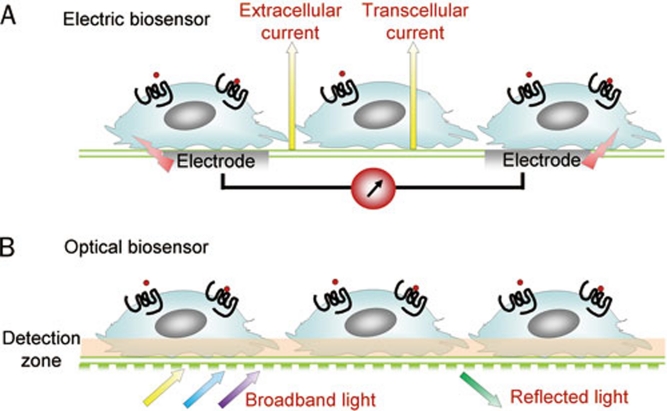Label-free technologies with the potential to substantially change some aspects of whole-cell assays, including GPCR screening, have emerged in recent years. These technologies detect changes in cellular characteristics including adhesion, proliferation, migration, and cell death, which are regulated by many different receptors, ion channels and signal transduction pathways. The advent of label-free technologies provides a different strategy for signal transduction measurement by using integrated or cumulative responses rather than the resolution of individual events.
Label-free whole cell assays typically employ a biosensor to convert the summation of ligand-induced changes in living cells into optical, electrical, magnetic, acoustic, calorimetric, or other quantifiable signals. In addition, these label-free assays do not require the addition of detection reagents, nor do they involve the expression strategies of forcing G-protein coupling or promiscuous G proteins, thus offering the potential for studying a more physiological state. Some label-free instruments have gained prominence in detecting GPCR function due to their ability to detect the activation of Gs, Gi and Gq signal transduction pathways. These systems are also used in ligand selectivity studies, endogenous receptor profiling, systemic cell biology studies, and many other aspects of GPCR research.
At Creative Bioarray, label-free instruments for GPCR screening use either an optical or electrical biosensor to detect cellular changes after stimulation.
Optical-based Systems
The optical biosensors utilize grating structures embedded in the bottom of microtiter plates. When illuminated with broadband or white light, these grating surfaces reflect a narrow band of light that is characteristic of the refractive index. The refractive index is very sensitive to changes in the concentration of biomolecules, which results in a change in the wavelength of the reflected light. At Creative Bioarray, available optical-based instruments include the BINDTM and EpicTM systems, both of which have been successfully used to study cell morphological changes and GPCR signaling.
Impedance-based Systems
Electrical biosensors, also known as impedance-based biosensors, mainly consist of substrates, electrodes and cell layers. Electrical-based detection has been used to study a wide variety of cellular events including cell adhesion and proliferation, cell morphological changes, and cell death. Now, it is generally believed that the impedance value is the sum of cellular events, including the relative density of cells on the surface of the electrode and the relative adherence of these cells. At Creative Bioarray, impedance-based biosensors provide a robust platform for a wide range of target applications to measure cell responses occurring in hours to days, including cell attachment, migration and wound healing.
 Figure 1. Principles of the biosensors for label-free whole cell detection.
Figure 1. Principles of the biosensors for label-free whole cell detection.
Highlights of Our Label-free Whole Cell Assay
- More fully characterized information about cellular and biochemical systems
- Pathway-independent analysis
- Non-invasive, more physiologically relevant data
- Ability to study difficult targets or weak biological interactions
Our unique cellular and biochemical label-free platform, in conjunction with labeled technologies, provides a unique orthogonal approach that enables you to make better decisions faster.
References
- Zhang R. et al.; Tools for GPCR drug discovery. Acta Pharmacologica Sinica, 2012, 33(3): 372-384.
- Scott C. W. et al.; Label-free whole-cell assays: expanding the scope of GPCR screening. Drug Discovery Today, 2010,15(17-18): 704-716.
- Receptor Binding Assay
- GTPγS Binding Assay
- Reporter Assay
- cAMP Assay
- Ca2+ Mobilization Assay
- IP3/IP1 Assay
- GPCR Internalization Assay
- Receptor Dimerization Assay